
* The Mi-8 proved a workhorse for the Soviet Union, and was also exported in considerable numbers. A navalized derivative, the "Mi-14", was also built, if in much smaller numbers. This chapter discussed the Mi-8 in Soviet / Russian service and in foreign service, and provides a history and description of the Mi-14.
* The Mi-8 quickly became a mainstay of Soviet military service, and was the workhorse of the Soviet war in Afghanistan in the 1980s. The Mi-8 served in troop carrier, gunship, combat SAR, and medevac roles, with field improvisations leading to production enhancements for both firepower and self-defense. As noted, the second-generation Mi-8MT was designed to provide improved hot-&-high performance, and as the Mi-8MT came into service it quickly replaced the Mi-8T operating in combat.
In the gunship role, "Hips" initially operated with 57-millimeter rocket pods or loads of general-purpose bombs. Pintle-mounted machine guns and grenade launchers were added later, though the grenade launcher had a nasty tendency to obstruct the door. The door-mounted weapons were preferred to the machine guns mounted on the stores outriggers, since the door-mounted weapons were less "draggy". Pods were also carried for dispersing mines.
Combat crews very much appreciated the basic sturdiness of the type, with "Hips" sometimes returning safely to base after being blasted full of holes. However, it is estimated that about 180 "Hips" were lost in the fighting. The "Hip" was also, as mentioned, a prime mover in the fighting over Chechnya in the post-Soviet era.
The Mi-8 series was of course heavily used by the Soviet state airline Aeroflot. It is somewhat ambiguous to call Aeroflot a strictly civil organization, since it worked as an arm of the Red military when the need arose, and in some cases Aeroflot machines were dedicated to military service. However, Aeroflot certainly did not operate helicopter gunships or ECM machines. One of the primary uses of Aeroflot "Hips" was in oil exploration and production, but they were also used for freight and passenger haulage to remote settlements; for fire-fighting; to set up telephone and power lines; for search and rescue or air ambulance operations; and even to cart hunting parties into the woods and back again.
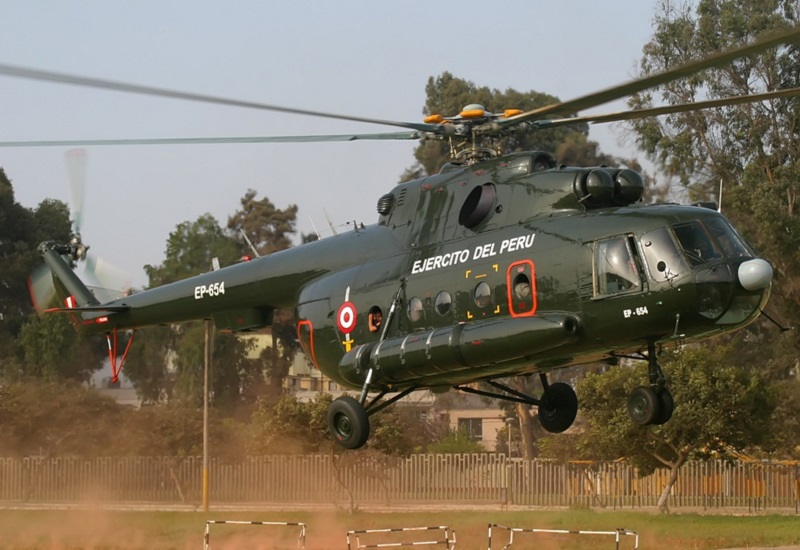
* By the beginning of the 21st century, thousands of Mi-8 helicopters had been obtained by dozens of nations. Many were "inherited" by Soviet successor states after the fall of the USSR, but many were purchased by governments or commercial firms that regarded the "Hip" as a good buy. There were so many users that it would be difficult, indeed exhausting, to discuss their usage in detail:
The USA is even an operator of the "Hip". Not surprisingly, some were obtained for operational test and training, but a few were obtained by American companies for overseas work. The US Central Intelligence Agency (CIA) operates a small fleet of "Hips", both because the machine tends to attract less attention in lands where it is often otherwise operated, and also because it is simply a good helicopter. CIA "Hips" tend to be generally painted in discreet colors with subdued markings, but there are images of CIA "Hips" used in active antiterrorist operations in Iraq painted flat yellow, with prominent American flags and "USA" painted on them.
Information on the actual operations of CIA "Hips" is unsurprisingly hard to come by. It is rumored that British special operations teams also used the "Hip" in Afghanistan, but there is no substantial evidence to confirm this notion.
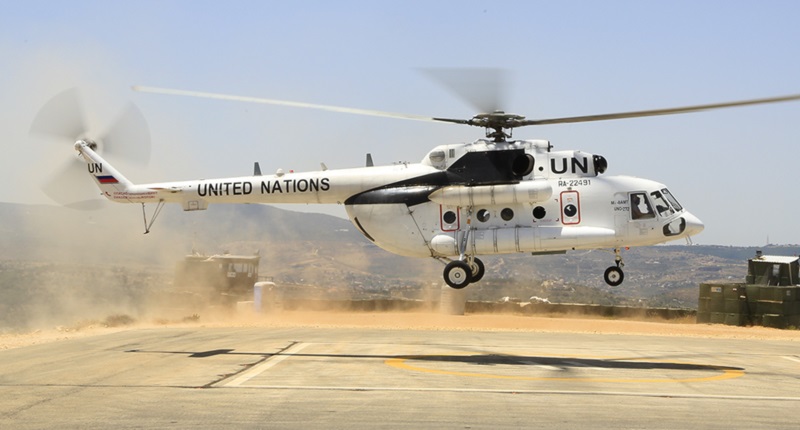
Of course, the "Hip" is very familiar in news videos of UN operations, being painted white with high-visibility UN ID. Sometimes UN Mi-8s were operated under contract by UN member states, particularly Ukraine, but in other cases they were leased and operated directly by the UN. In fact, the "Hip" is so important for international interventions that in early 2009, a "Hip Helicopter Task Force (HHTF)" was created under the umbrella of NATO to set up a common organization for deployment, operation, and support of "Hips" operated by ten NATO countries.
The Mi-8 is a sturdy and reliable machine, built for a long service life, and users tend to hang on to them for the long term, and there is a good market for upgrades. The Mi-8 promises to keep on flying well into the 21st century; it will not be that surprising if derivatives of the basic design are still flying after 2050.
BACK_TO_TOP* Even before the Mi-8 entered service, Soviet Naval Aviation (AVMF in its Russian acronym) was interested in a navalized derivative for antisubmarine warfare (ASW). The AVMF had found helicopters an excellent tool for coastal antisubmarine defense, but regarded the Mi-4M "Hound-B" then in service for the job as inadequate, and in fact the Mi-4M had been seen as a stopgap solution from the outset. Preliminary work on an Mi-8-based replacement for the Mi-4M, with the OKB designation of "V-8G", was initiated in late 1959, with detail design work begun in 1962.
Initial concepts envisioned the V-8G as being easily converted to a "hunter" or "killer" configuration, the opinion at the time being that the V-8G couldn't do both jobs at the same time. However, by the time full-scale development was authorized in the spring of 1965, the TV3-117 engine was available, providing enough power to support a single machine with both "hunter" and "killer" capabilities; a number of other changes were made in the concept at the time, and so the machine was given the new OKB designation of "V-14". The ASW offensive avionics suite for the V-14 was to be derived from that being developed for the Kamov Ka-25PL "Hormone-A" shipboard ASW helicopter.
The V-14 was to have a boat hull for amphibious operation. There had been some consideration early on of conducting ASW operations from the water's surface, conserving fuel, but that turned out to be impractical -- it would be unsafe and inconvenient in any but the calmest seas, and metal airframes don't get along well with salt water. However, it was obvious that it would be reassuring for aircrews to design a helicopter that spent most of its time over the waves to have the ability to set down on the water if the need arose.
The initial V-14 prototype -- converted from an Mi-8 airframe, and lacking operational kit -- performed its initial flight on 1 August 1967, with Mil OKB test pilot U.S. Shvatchko at the controls. It was powered by TV2-117 engines, the TV3-117 not being available at that time, and was painted in Aeroflot colors, despite the fact that Aeroflot had little or no interest in the type. Several other Mi-8 conversions were performed, with operational kit increasingly closer to production V-14 standard.
Flight testing was not completed until late in 1974 -- the ASW offensive avionics suite took a lot of debugging, and there were delays due to engine development as well. However, production of the V-14 as the "Mi-14PL", where "PL" stood for "Protivolodochniy (AntiSubmarine)", was initiated at Kazan in 1973, and by the end of flight trials production Mi-14PLs were being run through service evaluation. The type was accepted into service in the spring of 1976. An export variant was built in parallel, with a total of 273 Mi-14PL helicopters produced into 1986; a hundred of these machines were exported to ten countries. NATO assigned the Mi-14PL the reporting name "Haze", changed to "Haze-A" when other variants appeared.
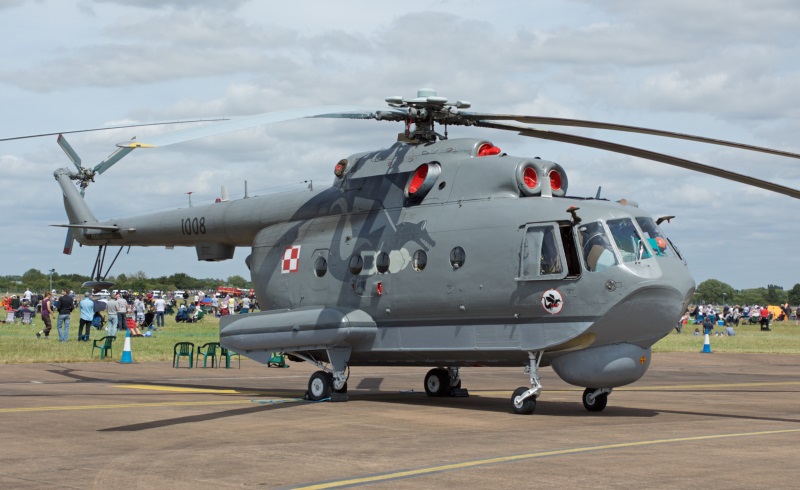
* The engine and tailboom assembly of the Mi-14PL looked much like that of an Mi-17, with TV3-117M engines -- the "M" effectively standing for "marinized", the engines being corrosion-protected to withstand salt water spray. Early production had the tail rotor on the right side of the boom, but it was moved to the left in later machines. There was a small float under the tailboom near the tail rotor. The fuselage had a similar cockpit, door, and porthole arrangement to military Hips, but of course it had the boat hull and no clamshell doors in the rear. Landing gear was also entirely different, with four retractable assemblies -- twin wheels on the main gear, single wheels on the nose gear. The main gear retracted into sponsons, which popped out flotation bags for a water landing. Early production machines had undercarriage doors, but the doors were deleted in later production.
___________________________________________________________________
MIL MI-14PL "HAZE-A":
___________________________________________________________________
main rotor diameter:
21.29 meters (69 feet 10 inches)
tail rotor diameter:
3.8 meters (12 feet 6 inches)
fuselage length:
18.31 meters (60 feet)
footprint length:
25.35 meters (83 feet)
height (tail rotor):
5.54 meters (18 feet 2 inches)
height (rotor head):
4.76 meters (15 feet 7 inches)
empty weight:
7,160 kilograms (15,785 pounds)
max loaded weight:
12,000 kilograms (26,455 pounds)
maximum speed (performance specs at normal loaded weight):
250 KPH (155 MPH / 135 KT)
service ceiling:
4,500 meters (14,760 feet)
range:
425 kilometers (265 MI / 230 NMI)
___________________________________________________________________
The Mi-14PL was built around the Kal'mar ASW offensive avionics system, which included:
Weapons were carried in an internal weapons bay, with the warload consisting of either a single homing torpedo or various arrangements of depth charges and depth charge clusters. The Mi-14 could also carry a single nuclear depth charge. There were tests with carriage of the Kh-23 (NATO AS-7 Karen) air-to-surface missile, but that weapons configuration never went into service.
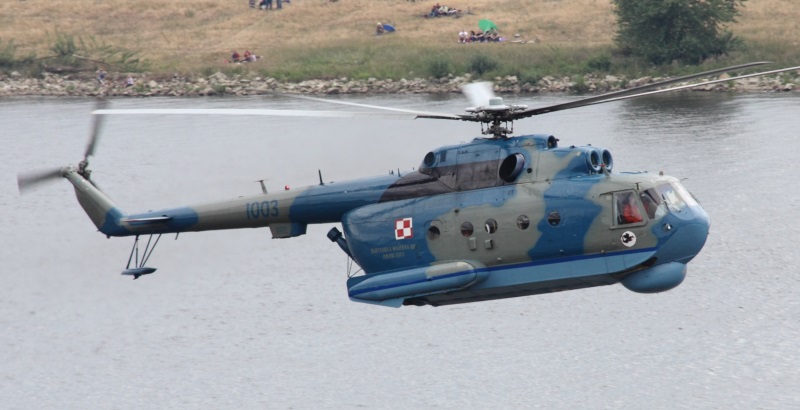
* From 1973, there was an effort to replace the Kal'mar ASW system with the improved Os'minog digital-analog system, featuring improved sensors and much improved processing capability. Initial flight of an Mi-14 with the Os'minog system was in December 1975; the variant was accepted for service as the "Mi-14PLM" but the basic Mi-14PL remained the production standard. It is believed that a few Mi-14PLs were upgraded to Mi-14PLM standard.
Also from 1973, there was an effort to develop a mine countermeasures (MCM) variant of the Mi-14, which entered service in 1979 as the "Mi-14BT", where "BT" stood for "Buksirovschich Tralov (MCM Sled Tow)". It retained the radome of the Mi14PL, but of course dropped most of the Mi-14PL's combat avionics, replacing it with an MCM sled tow system. Windows were added to the rear of the fuselage to allow the MCM operator to keep track of the sled, with searchlights also fitted to assist in night operations. For whatever reason, a long strake was added low on the fuselage on the right side of the machine. A range of different sleds could be towed to deal with different classes of mines. The Mi-14BT was assigned the NATO reporting name "Haze-B"; no more than 30 were built, with a few exported to East Germany and Bulgaria.
Other work was done in parallel on a search and rescue variant, which emerged in 1979 as the "Mi-14PS", where "PS" stood for "Poiskovo Spasatelniy (Search & Rescue)". It had a double-wide sliding door and an extensible heavy-duty winch; it also had the fuselage strake as fitted to the Mi-14BT. The Mi-14PS was fitted with searchlights under the nose and tailboom, could carry life rafts and other survival kit, and could accommodate up to 19 survivors, including two on litters. Apparently it had tow gear to pull along life rafts. The Mi-14PS was given the NATO reporting name of "Haze-C".
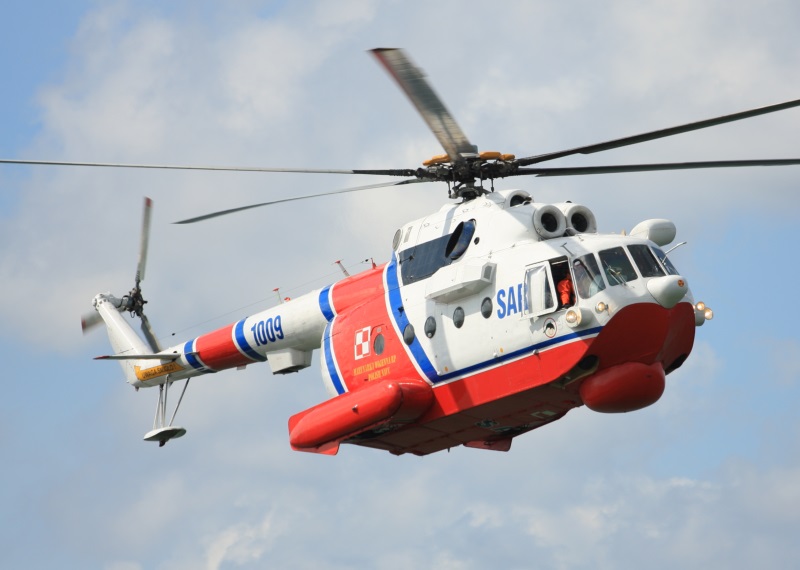
* There were a number of minor modifications of the Mi-14, for example one for assault landing training and one for anti-commando operations, but details of these subvariants are unclear. In the wake of the fall of the USSR, there were schemes to convert demilitarized Mi-14s to a civilian cargo-transport-SAR standard, the "Mi-14GP", and to a fire-fighting standard, the "Mi-14PZh", but no more than a few such conversions were performed. The Mi-8 was really the preferred machine and few saw any reason to bother with the Mi-14. At last notice, some Mi-14s linger in service with Russian forces and with ex-Warsaw Pact forces.
BACK_TO_TOP* Sources include:
* Illustration credits:
* Revision history:
v1.0.0 / 01 feb 09 v1.1.0 / 01 mar 09 / Fast upgrade to fix rough initial release. v1.1.1 / 01 may 10 / Review & polish. v1.1.2 / 01 may 12 / Review & polish. v1.1.3 / 01 apr 14 / Review & polish. v1.1.4 / 01 mar 16 / Review & polish. v1.1.5 / 01 feb 18 / Review & polish. v1.2.0 / 01 nov 21 / Some rewrite, illustrations update. v1.3.0 / 01 nov 23 / Some rewrite. v1.3.1 / 01 nov 25 / Review, update, & polish.BACK_TO_TOP
